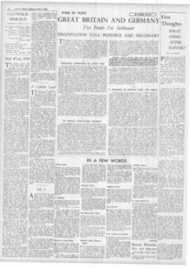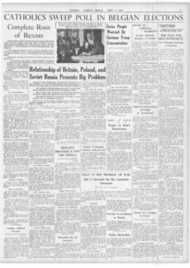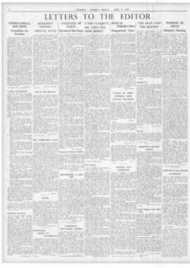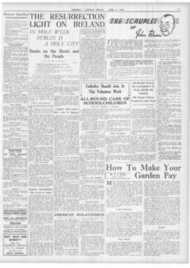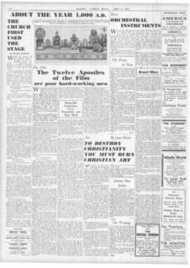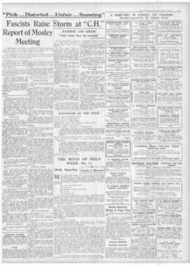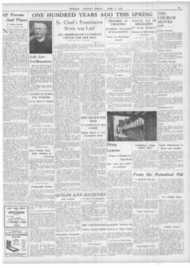Page 13, 6th April 1939
Page 13
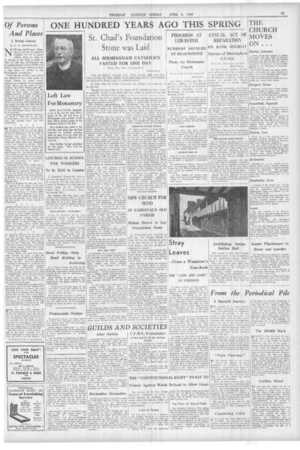
Report an error
Noticed an error on this page?If you've noticed an error in this article please click here to report it.
Tags
Share
Related articles
Church Starts On 2s. 6d.
C.t.s. Honours City Of
Birmingham Celebrates The
Birmingham Bombing : The Aftermath
80 Years' Tradition In Church Music Splendid Record Of...
Ancient Treasures Of Modern Church
ONE HUNDRED YEARS AGO THIS SPRING
St. Chad's Foundation Stone was Laid
ALL BIRMINGHAM CATHOLICS FASTED FOR ONE DAY
Front Our Own Correspondent
thamixottAm.
ONE HUNDRED YEARS AGO, THIS YEAR, THE FOCNDATION STONE OF THE FIRST POST-REFORMATION CATHEDRAL IN ENGLAND WAS LAID IN BIRMINGHAM.
In June, 1941, St. Chad's Cathedral will eelebrate the centenary of its opening.
Though the exact date of the laying of the foundation stone is not s6 accurately known, it was about this time, within a month or two, that a crowd of piously-excited people made their way down a rugged hill
and into a narrow thoroughfare to witness the historic ceremony. With felicitous appropriateness the stone was well and truly embedded in the heart of England, for Bath Street, Birmingham, by its very geographical position, is near the centre point of the country. In the Midlands, they are not going to forget this great date on which an architect named Augustus Welby Pugin stood on the scaffolding of pious dreams and shaped a Gothic pile which was to become so much a pail. of the Catholic future. The great edifice that gradually came into being was opened for public worship two years later, on June 19, 1841. Canon John Roskell has been Administrator of St. Chad's for the past two decades, a longer period than any of his predecessors, and loving, as he does, every stone of the mellowed building, he cherishes the hope that every man and woman, boy and girl who were spiritually nurtured at St. Chad's, and also the many thousands who, at some time in their lives, have found a ternporary haven amidst the silences of the ancient edifice, will not forget to help him to give the old home of revived Catholicism its necessary renovation.
NEW IDEAL IN CHURCH BUILDING One of the many features of the Catholic revival in England in the middle of the last century was the introduction of a new ideal in church building. The foremost promoter was Pugin. At the time when his genius was at its maturity there had sprung up in the country a spirit of admiration for the ancient abbeys and cathedrals which were a part of England's inheritance from the ages of Faith. Pugin was an enthusiast for the medieval spirit. He studied It at home and abroad, and when he became a Catholic in 1834 he brought with him, and placed at the disposal of the religion of his adoption, a mind stored with a vast knowledge of Catholic architecture, and an energy which has left enduring witnesses in the many churches which were designed by him on the ancient models. Pugin was greatly proud to have been chosen to plan the first Catholic cathedral in the country for many centuries, a pride which was shared by John, Earl of Shrewsbury, who became one of his chief patrons, and contributed munificently to the cost. Another supporter was John Hardman, whose family to-day is known throughout the length and breadth of England that is Catholic. Dr. Wiseman also lent his commanding influence to the work. No time was lost, and as the months went by the excitement among Catholics increased, and they looked forward with anxious expectation to the completion of the sacred building.
ONE DAY FAST On Saturday, June 19, 1841, a fast was observed by Birmingham Catholics as an immediate preparation for this solemnities of the opening, and on the next day the relics of St. Chad, the patron saint, which had been recently discovered, were brought over from Oscott. Early on Monday the Cathedral was consecrated. Crowds gathered outside, and as Bishop Walsh addressed them, Mr John Hardman stepped forward with a number of Catholic gentlemen, and read the following from a parchment:
" In the name of the Holy and Undivided Trinity, Amen. We the Catholics of Birmingham, mindful of God's mercy towards us, and come trusting to share His bounty for the time to come, do, by these presents, make a free and voluntary surrender of all we have hitherto given towards the erection and advancement of the Cathedral about to be oonseera fed to-day."
The ceremony then proceeded, and the relics of St. Chad were carried solemnly into the church, where they have since remained. The latter part of the day was given over to a banquet in the Town Hall, where Lord Camoys presided, and sat with thirteen bishops on a raised dais. Pugin, of course, was present, but on rising to acknowledge a vote of congratulation, was too overcome, and merely asked that the clergy should remember him in their prayers. The sum raised in money at that time for the building was £19,500, but in the years leading to the present, much has been spent on interior embellishments. The spires of St. Chad's rise in the midst of a locality that lies at the back of the principal streets of Birmingham.
GOTHIC IN EVERY DETAIL St. Chad's is Gothic in every detail— its architecture, church furniture, painted glass and brass work. Nave and aisles are spanned by a single pointed roof. This is mainly supported by a double line of lofty pillars, whose arches run up into the roof. Though the building is not actually cruciform, the architecture. and windows below the chancel suggest a double transept. Looking up the Cathedral toward the sanctuary, attention is at once arrested by the high screen of wood surmounted by the Holy Rood. It is the figure of the Crucified raised up high in the .dimness of the chancel arch, which dominates the whole building, as if teaching with solemn emphasis the great truth that sacrifice and prayer and devotion to the Catholic Church are offered " in the face of Christ Jesus."
Everywhere are epitomised stories of the last century, of Walsh's staunchness, Wiseman's leadership, Newnian's {aspiration, Ullathorne's strength, Iisley's piety—tales in tablet or stone, the walls of St. Chad's keep glorious memories soon to be reawakened in the celebrations of a hundred years of history.
blog comments powered by Disqus







